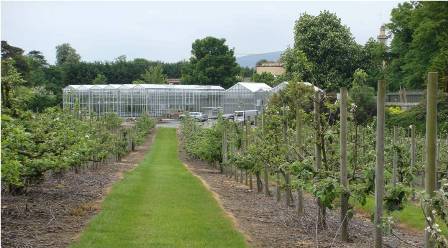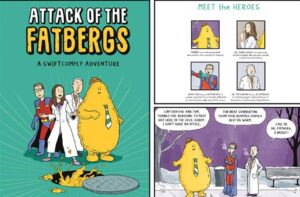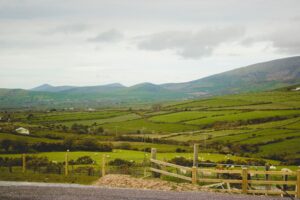The trees of Belfield Campus, beekeeping in Rosemount and the misunderstood Sitka spruce with Dr. Brian Tobin, School of Agriculture and Food Science.

Brian Tobin
Assistant Professor
UCD School of Agriculture and Food Science
UCD Profile
Q: How did you get into forestry? Have you always liked nature and trees?
A: Yes actually. I have enjoyed the outdoors from childhood and have always been curious about how things work. It is easy to be inspired by trees (the tallest living organisms on earth) and by their considerable impact on the landscape and this led me to forestry. It has been something of a frustration having studied forestry, to be qualified in forest land management but yet not having any land to afforest myself. This remains a dream for the moment!
Q: Tell us some of the interesting and useful things that trees and forests do for us
A: My main research projects relate to carbon sequestration by forest ecosystems, an assessment of the potential of short rotation forest systems and tree improvement. The main tasks include collecting information to describe the responses of various aspects of trees or forests to changes in their environment.
Trees and forests traditionally provided our race with shelter, fuel and timber. We have developed our understanding in time and appreciate that forests are responsible for oxygen production, for supporting an almost incomprehensible biodiversity, for intercepting, filtering and sending water into the atmosphere and building rain clouds (not that we have always valued this point particularly highly in these parts), and for intercepting and filtering tremendous quantities of pollution out of the atmosphere.
The pollution aspect has developed considerably in recent decades as we have begun to realise the considerable role trees play in the terrestrial carbon cycle in the sequestering of carbon dioxide out of the atmosphere where it contributes to driving climate change, although this sequestration must be actively managed to maximise the benefit. (As an aside, I still find it almost magical that a colourless gas, which we breath out ourselves, can be converted to hard, versatile wood matter by plants).
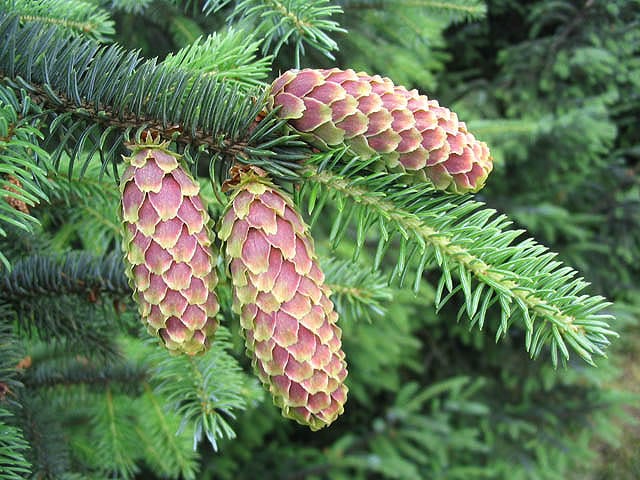
“Apparently, there are now more Sitka spruce trees in Ireland and the UK than there are in the species’ natural range in North America. Fifty one percent of our forest estate is composed of this species”
– Dr Brian Tobin
Q: Can you tell me about the history and use of forests in Ireland?
A: Ireland has an interesting, if somewhat regrettable history when it comes to forests. Currently 11% of our land surface is under forest, and we have fought hard to increase this from a low point of about 1% just over 100 years ago. Though the country at one point had significant forest cover, probably over 50% prior to the medieval period, there have been a series of periods where successive clearings of the land removed the majority of forests and woodland. The dwindling of forest cover to such low levels has resulted in a loss of much of the associated culture and lore. To such an extent that many (if not most) farmers and land managers, and indeed the majority of the population, no longer have much affinity for forestry as a production system.
In our efforts to build up a forest industry from almost nothing, the State introduced protection for forest lands and insisted that where forest was planted it was compulsory to replant it. Although it was designed to protect the considerable national investment in forests, it is probably the single-most important factor in preventing the further planting of new forest area. Land owners don’t trust the obligation to remain “in forestry” that comes with new planting, despite the fact that it is nearly always economically more beneficial than many other land uses.
Another aspect that sadly is misunderstood is the use of Sitka spruce – a non-native coniferous species (such a phrase has become akin to mentioning the devil’s name in certain parts of the country!). Irish forestry needed a champion and found one with Sitka spruce. Sometimes described as the Friesian of Forestry, this species is the workhorse that has proved to be tremendously productive on such a wide range of our soft and wet soils.
Apparently, there are now more Sitka spruce trees in Ireland and the UK than there are in the species’ natural range in North America. Fifty one percent of our forest estate is composed of this species, which underpins an industry with a gross annual output of approx. €2.2 billion. When I began in forest research, I was not terribly keen about this prickly contender, however the more time I spend with the species the more admiration I develop for it. Quite simply, it manages to work miracles in the most difficult of circumstances and produces a very versatile timber with very little silvicultural input. We need better management of it and more diversity in our forestry, but I firmly believe that Sitka spruce should remain a significant part of forestry here, to the point of (dare I suggest) being awarded honorary “future native” status! We in Forestry need to do a better job of imparting a better understanding of this truly impressive tree.
Q: Tell us a little bit about the apiary you set up and manage at Rosemount and what you’ve learned from managing that!
A: One of the things I have learned from managing the bees at Rosemount is the absolute danger involved in working with fascinating creatures, in a place that I really like and among people I respect and appreciate enormously. I am an optimist by nature and I often catch myself saying “I will just pop over quickly to Rosemount to check on colony x” etc. That almost never happens since Rosemount is like a blackbox for time. There is always someone interesting around to have a word with, something unusual happening, and the bees themselves almost never fail to present something different and unexpected.
I find it a particular pleasure in having the privilege of introducing people to the amazing details of honeybee activities, either through undergraduate teaching or outreach activities. The bees are an easy sell, especially these days of increasing public awareness of the difficulties experienced by pollinators. I think the apiary is something that fits neatly among the other activities at Rosemount. The tireless bees forage busily from the surrounding boundary trees and orchard fruit trees, the community gardens and from around the glasshouse areas. Meanwhile, the study of plant reproduction and growth continues underneath and within the various buildings. I am delighted to be able to work with bees in a university research environment where curiosity in such deeply interesting animals is so easily rewarded -even if at a terrible cost of time.
I have great supports at Rosemount. I have the pleasure to have a partner beekeeper at the apiary, Kieran Harnett keeps an experienced eye on me and lends a hand every time he finds me doing something particularly stupid. Bredagh Moran and David Brogan are always on hand to help with the various hare-brained schemes I have attempted. It is fantastic also that Dr Dara Stanley and her research team are also so active alongside in Rosemount investigating bumblebee and non-bee pollinator species. Honeybees tend to claim the headlines but are protected in ways by beekeepers. Other pollinators are less lucky and their loss could affect our food chain significantly. Working among the Rosemount “family” is a particular pleasure and is yet another reason I am delighted to have the apiary there.
Q: For Earth Week in 2020 you agreed to tell us about some of your favourite trees. What are they?
A: Well, I find it hard to choose a favourite tree anymore – there are too many and like vegetables, they need to be in season! At this time of the year, I’d suggest a handful; two broadleaved species and a couple of majestic conifers.
Firstly, sycamore, is really coming into season right now and is creating a buzz with all the recent warm and sunny weather. Their Latin name is Acer pseudoplatanus. They have only recently begun to flush out their new foliage for the year. I think we often sneer later in the year at sycamore leaves as they obstruct the light, casting deep and heavy shade on us, as well as playing host to armies of aphids.
The leaves often seem somewhat drab, however right now the tender leaves have begun freshening from their initial tender red colour to a magnificent golden green. Emerging surreptitiously inside this canopy are a myriad of green flowers, unfurling downwards to tantalise every passing insect with an almost irresistible offering of lush pollen and rich nectar. The bees at Rosemount are currently spending a tremendous amount of their time with these trees which happily skirt around the facility’s boundary.
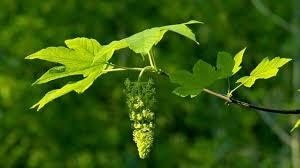
Sycamore
“Emerging surreptitiously inside this canopy are a myriad of green flowers, unfurling downwards to tantalise every passing insect with an almost irresistible offering of lush pollen and rich nectar.”
– Dr Brian Tobin
Q: The second tree is a Monterey Cypress, tell us about that
A: The West coast of America is the home range of so many of my own sylvan heroes, I still haven’t been. So many of the trees that have done so well on our shores hail from there. Another of my favourite trees is number 13 on the UCD Notable Trees list (part of the UCD Woodlands Walk Map & Guide): a massive Monterey cypress (Cupressus marcocarpa pendula)-this particular a weeping variety. I spend a lot of time in Rosemount and I prefer to walk past the creche so I can pass under this particular architectural beauty.
I grew up beside two of these monsters and developed a love of climbing on their dusky soft bark and among the wonderfully lemon-scented foliage. I built my first tree house in a Monterey! Coming from the same part of the world is the Monterey pine (Pinus radiata). On campus we have an impressive series of stately (but understated) individuals guarding the rear entrance to the UCD Conway Institute. They tower over the oak walk too but one rarely sees them since they stand well back, towering aloft. If you ever have to entertain children while on campus I suggest you take them hunting giant pine cones around the feet of these impressive trees.
The species has all but died out from its home territory on the Monterey peninsula and are now far more common almost anywhere else. I used to feel it was rather sad, but I came across an interesting article from 1968 about Monterey tree species in Ireland. Mitchell makes an excellent point and suggests that many trees probably don’t like living among “the beach huts and golf courses” of Monterey but just have to live there because of a freak accident of migration
Monterey Cypress
“The species has all but died out from its home territory on the Monterey peninsula and are now far more common almost anywhere else”
– Dr Brian Tobin

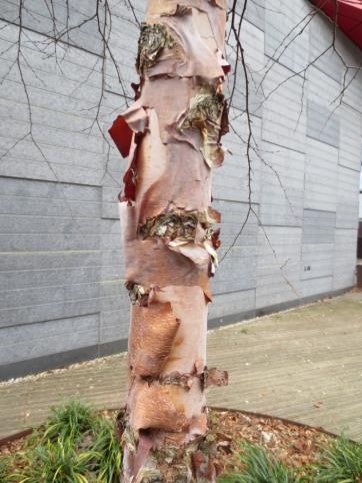
Q: Your final tree is the native birch
A: Last, and considerably more modest, is our own humble birch. Belfield, in common with the greater Dublin area (along with too many of our towns and villages too if you ask me!), is full of them. However, one of UCD’s smallest is attempting to inveigle its way into our collective consciousness by an unusual route. Somehow it has set itself up as a modern-day sacred tree – no less! No doubt while rushing between the soaring open facade of the O’Brien Science Centre to the shelter of the Library concourse you may have noticed the furtive Resilience Tree, shyly observing the lake from beside the giant chess set.
Mc Loughlin (2019) has made some interesting observations about how we as humans have an innate and age-old connection with trees, but even in an increasingly secular time, still maintain a need for sacred trees. While thinking about this, my own conscience pricks me for being scornful about the common and everyday birch. Though I still cannot regard it as a favourite, I do grudgingly admit a little admiration and accept that it may be considered “in season”. It is probably fitting that it was selected to be the local hero to champion our mental health, hope and resilience at UCD. Could we ask for more in these limited and restricted times
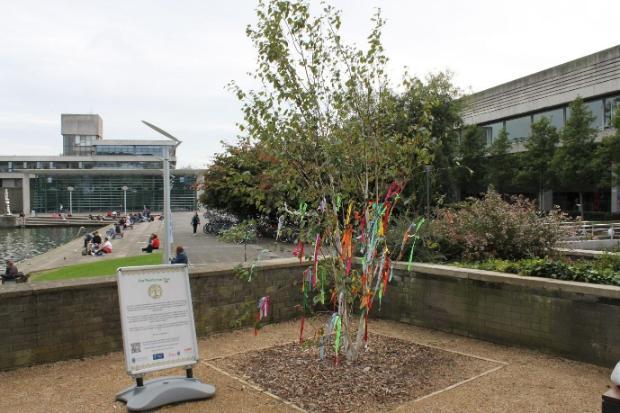
UCD’s Resilience Tree
“No doubt while rushing between the soaring open facade of the O’Brien Science Centre to the shelter of the Library concourse you may have noticed the furtive Resilience Tree, shyly observing the lake from beside the giant chess set.”
